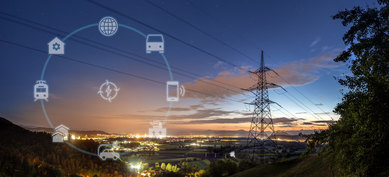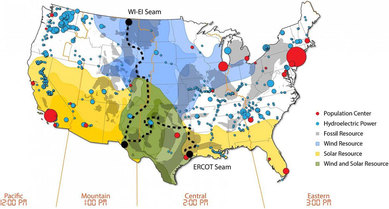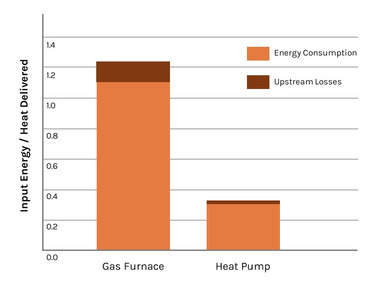Now is the Time – Dispelling the Myths of Electrification and Decarbonization
Electrification has a vital, immediate role to play on the road to deep decarbonization. We need to quit arguing it doesn’t.

There has been an increasing number of articles and op-eds arguing that we cannot electrify our building systems and charge our electric cars sustainably because of the limitations of the current U.S. power grid. Most of them are variations on the theme We’re not ready for electrification: the grid isn’t ready, buildings aren’t ready, consumers aren’t ready, other things need to happen first. The Wall Street Journal even added “We don’t have enough electricians” to their growing list of why now is not the time for electrification.
While many of the articles point out important issues that need to be addressed, the problem with the larger “not yet” argument is it’s fundamentally incorrect. We can change BOTH our building and power grid infrastructure at the same time to decarbonize. In fact, building electrification should be done in conjunction with upgrading our power grid if we intend to decarbonize within the timeframe the planet requires.
Myth: There is a lack of a clean grid transition in the U.S., so electrification of building systems is swapping one carbon-intensive resource for another.
Electrification encounters perplexity (and at times critical dismay and concern) stemming from the idea of a “dirty grid” that seems like it shall remain now and forever that way in the United States. Those who feel that way want renewables to become a larger part of the grid mix before electrification happens.
Although grid modernization has become a less topical hot-button issue since 2016, there certainly is creative and practical ambition to upgrade and create the “future” grid of the US. There is a concrete plan (that is, in fact, both cool and practical) on how our three regional grids come together. The Coasts become major renewable producers (with Rhode Island becoming pretty much a big battery!). Perhaps most excitingly, the Northwest essentially becomes the Sweden of America and hydroelectric power starts spreading even further, while the Southwest utilizes its ample sunlight to full capacity.
While this might sound overly futuristic, 2022 was the first year in US history that renewable generation capacity exceeded the generation of coal. We should feel reassured that the mix of electrons in the grid is becoming less carbon intensive – and not assume this transition will lag behind or not get accelerated by the electrification of buildings. We are also seeing a steady increase in the use of on-site renewable energy generation – signaling a larger trend towards buildings becoming both producers and consumers of energy.

Future U.S. grid from the Interconnections Seam Study, National Renewable Energy Laboratory (NREL)
Myth: The power grid won’t be able to accommodate electrification and increased usage of electric vehicles.
There is equal confusion about the grid having the capacity for electrification. No one asked if the grid could handle the introduction of air-conditioning in the middle of the last century, nor if the grid could handle industrialization. In fact, the grid was built and adapted over time to do just that.
Voltage upgrades have been happening on a regular basis in cities around the world since the turn of the century. New technology is constantly being invented to improve grid management. Electric utilities across the United States are legally required to upgrade a circuit to a higher voltage; they also report to a public-utilities commission, meaning that they are recognized as a critical service provider. If they don’t have the capacity to support economic development, government agencies will collaborate to ensure that upgrades occur and development is not stifled.
In addition to reducing loads by utilizing more efficient systems like heat pumps, load shifting – moving energy use to off-peak hours when energy demand is lower – will allow the existing grid to accommodate the anticipated changes of electrification. Onsite renewables are another strategy to reduce grid demand. Thermal storage strategies can also store excess energy during periods of low demand to supplement periods of high demand (and can take pressure off the future battery that is Rhode Island).
Myth: Electrifying buildings won’t work in cold climates.
This is arguably the biggest myth that is inhibiting electrification in many parts of the U.S. The key here is that not all electrification technologies for heating are created equal. It takes around 1/3 of the energy to move heat around with a heat pump as it takes to create heat by burning natural gas or using electric resistance heat. Building operators and mechanical engineers in heating climates shutter at the thought of electric heat, if only for the operating cost! But it is important to understand that when we talk about electrification of heating systems, we mean utilizing heat pump technology, not electric resistance heat.
Another challenge for cold climates is that as outside air temperature decreases, air-source heat pumps lose efficiency and eventually struggle to operate at very low temperatures. Geothermal and other water-source heat pumps are critical to high-efficiency operation regardless of outdoor temperature and are ideal for cold climates. Ground-Source heat pumps also have the benefit of using thermal storage in the ground as seasonal energy storage; this allows waste heat from summer air-conditioning to be stored in the ground, providing exceptional ground temperatures to support high-efficiency heating in the winter. When combined with efficient building upgrades, ground-source heat pumps not only provide exceptional performance but can do so without significantly increasing electrical peak demands.
It’s important to remember that the first step for any building design or retrofit is reducing the load as much as possible. For heating this includes improving the envelope, using heat recovery where possible, and providing demand-controlled ventilation. And once the building heating equipment is electrified, it can be powered by renewable electricity sources such as solar, wind, or hydro.
When we demythologize the main arguments against electrification, it becomes clear there is no likely scenario where everything will be electrified all at once without simultaneous improvements in grid mix and grid and building performance. There is, however, a scenario where we wait too long to electrify and our buildings aren’t net-zero ready in time to reach critical global decarbonization goals. The path forward is smart building electrification: reducing loads, using heat pumps, shifting loads to off hours, and using onsite renewables and thermal storage while upgrading the power grid to cleaner, renewable energy resources.
According to the International Renewable Energy Agency, “renewable energy and electrification alone can deliver 75% of energy-related CO2 emissions reductions needed. Renewables and energy efficiency, boosted by substantial electrification, can provide over 90% of the necessary reductions in energy-related carbon emissions.” If we do all this work thoughtfully at the same time, we CAN electrify to decarbonize. Most importantly, we need to start accelerating all these interrelated efforts now, with focused commitment on our responsibility for future generations.
